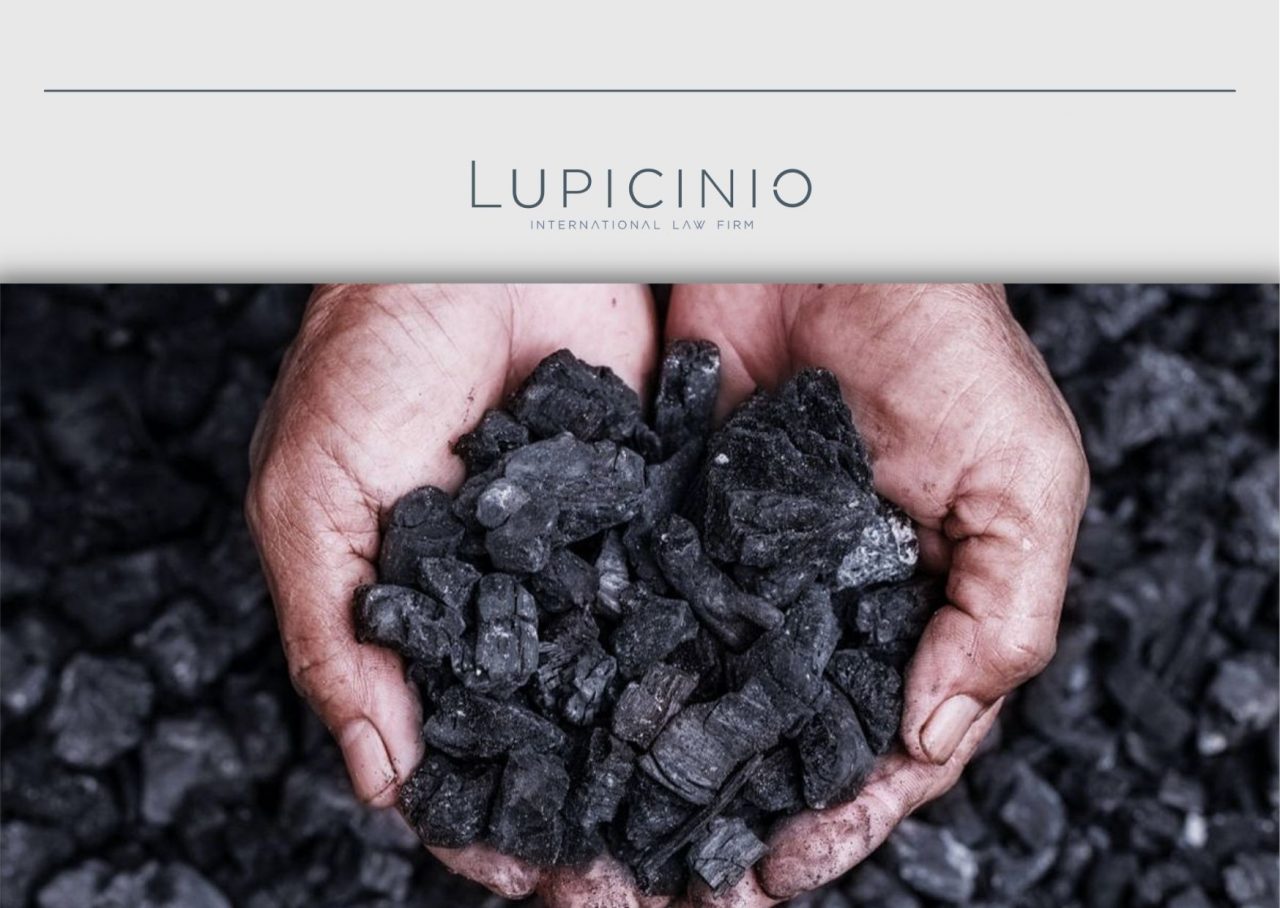SUMMARY
In this article, we will analyse the current situation of the energy market and the legal and economic possibility of recovering coal as a source of energy. In recent years, the Energy Department of Lupicinio International Law Firm has been advising concessionary companies that exploit coal in all operational areas, from obtaining exploitation concessions or other types of permits and authorisations, to the transport and marketing of domestic thermal coal, including the approval of the corresponding work plans or the obtaining of subsidies of various kinds.
INTRODUCTION
Today, the world energy crisis is much more intense than that of the 1970s, since the current crisis involves all the main energy sources and not only oil, as on that occasion. As we know, this crisis was not caused by the war in Ukraine, as the latter only aggravated a situation previously caused precisely by the unsatisfied demand for coal in China after the pandemic caused by covid-19[1] , which made this energy resource more expensive. This rise in price has in turn been passed on to gas and oil (or should we say oil-based fuels such as petrol and diesel), which have seen their prices soar to unprecedented levels, and is causing the European Union countries hardest hit by the war to turn their eyes towards the reviled coal.
- The use of thermal coal in the current economic climate.
Until relatively recently, approximately 37% of the world’s electricity was produced by coal, using various technologies to generate electricity from coal, such as conventional thermal power plants, integrated gasification combined cycle and hybrid combined cycle systems.
However, the legal framework promoted by the European Union to reduce carbon emissions since at least Directive 2003/87/EC has led to a reduction in the share of this resource in energy production in Europe, to the point that in 2021, for example, and according to the OMIE annual report for that year, the contribution of energy produced in coal-fired thermal power stations to the energy mix in Spain will have been reduced to 1.2% of the total.
Also in our country, Law 7/2021 of 20 May on climate change and energy transition, one of the objectives of which is to facilitate the decarbonisation of the Spanish economy, has recently been approved; the National Integrated Energy and Climate Plan (PNIEC) 2021-2030 has also been approved, which aims to reduce greenhouse gas (GHG) emissions by 23% compared to 1990 (inspired by the 2015 Paris Agreement on climate change, adopted at the 21st Conference of the Parties to the United Nations Framework Convention on Climate Change).Finally, the Just Transition Strategy has been approved, which will seek to maximise the employment opportunities of the transition to a low-carbon development model.
In short, the policies promoted by both the European Union and the United Nations themselves have been committed to a drastic reduction in the use of coal in energy production, with the result that in our country the exploitation of domestic coal has almost entirely disappeared and the thermal power stations have been dismantled, with only the Soto de Ribera and Aboño power stations in Asturias, Los Barrios in Andalusia, As Pontes in Galicia, which operates with international coal, and Es Murterar in Mallorca remaining open in Spain to this day.
However, we can see that outside the European Union, the use of coal in electricity production does not stop, nor, paradoxically enough, does it stop importing electricity generated in coal-fired power stations, as in the case of Spanish imports of electricity from thermal power stations in Morocco.
- Not in my back yard
Indeed, the European Union and of course Spain still apply the environmental principle “not in my back yard”, which has allowed, according to the OMIE report for 2020, Spain to increase by 485 % (to 1.053 GWh) its imports of electricity produced in the two new coal-fired power plants that Morocco has opened, production that does not count in the CO2 market and is therefore not reflected in its environmental reports on greenhouse gas production, while in Spain coal mining and thermal power plants are being closed.
Spain has also increased its imports of gas from the United States, produced using the hydraulic fracturing technique (fracking), as a result of various factors such as the tension with Algeria and the war in Ukraine.
However, and almost at the same time, the new Climate Change Law prohibits the granting of exploration authorisations, hydrocarbon research permits or exploitation concessions for the same, regulated under Law 34/1998, of 7 October, on the hydrocarbon sector, and Royal Decree-Law 16/2017, of 17 November, which establishes safety provisions in the research and exploitation of hydrocarbons in the marine environment, as well as the granting of new authorisations for hydrocarbon exploitation activities in which the use of high-volume hydraulic fracturing is foreseen.
- Environmentally friendly yes, environmentally ineffective no.
This is not the time to discuss the coherence of such an approach to environmental protection, but only to point out that any policy which omits the systemic consideration of the planet as a whole is, on principle, ineffective from the perspective of environmental protection, since there is no point in banning in Europe certain actions with an environmental impact that are considered environmentally negative, when at the same time energy or hydrocarbons produced using the same techniques that are banned in Europe are purchased under conditions that are even more harmful to the environment than those that would have been the case if the energy or hydrocarbons had been produced or extracted in Europe.
What we are interested in at the moment, in an environment such as the one described above, is reducing both Spain’s external energy dependence and the price of energy, and in the pursuit of this objective, we cannot disdain any energy source at the moment.
As far as the use of coal is concerned, there are legal, technical and economic constraints to its reuse in energy production.
- Legal status
From a legal point of view, and as a consequence of Council Decision 2010/787/EU of 10 December 2010 at European level and the subsequent approval of the Closure Plan of the Kingdom of Spain for non-competitive coal mining, successive calls for aid for the closure of non-competitive coal mines have been approved, such as those provided for in Order IET/2095/2013, of 12 November, which establishes the regulatory bases for aid for the financial years 2013 to 2018 specifically aimed at covering current production losses of production units included in the Kingdom of Spain’s Closure Plan for non-competitive coal mining.
Under the strategy designed, all Section D) coal mining concessions that received this aid had to close by 31 December 2018 or repay the aid.
However, there are still mining concessions for the exploitation of thermal coal that for various reasons did not receive such aid, so that from the point of view contemplated in Law 7/2021, of 20 May, on climate change and energy transition, mentioned above, they would be in a position to compete in the current market if they were put back into operation, during the limited period of time that the current economic situation lasts, as we have been informed by various customers who have expressed interest in the reopening of coal mining concessions currently in force.
- Need for thermal coal
On the other hand, there is the need to use thermal coal in thermal power plants that are still in operation and that can accept domestic coal. The thermal power plants began to request decommissioning authorisations, due both to the policies of reducing electricity production from coal and to the regulatory requirements of the European Union, which demanded that these installations introduce denitrification and desulphurisation procedures that entailed costly investments, These investments were not guaranteed in the long term, in view of the commitment to reduce the use of thermal coal, so that the plants that did not undertake such investments by 2020 had to close due to the application of Directive 2010/75/EU of the European Parliament and of the Council, of 24 November 2010.
As there are still some thermal power stations in operation, it is possible to use them, even temporarily, for energy production, and of course we are seeing how other countries around us, particularly Germany, have openly opted for this technology.
Likewise, the International Energy Agency, among the measures it is proposing to solve Europe’s energy problem, includes that of providing incentives through aid for energy production in thermal power stations. It is no coincidence that the European Commission is in favour of substituting gas for coal, and as part of the “Save gas for a safe winter” plan, which it approved on 20 July 2022, it proposes to encourage the reactivation of coal-fired power stations by means of public subsidies to make the consumption of the mineral affordable.
- CO2 market in the European Union
For the coherence of all this, we cannot forget the fundamental factor of the price of CO2, which is a market regulated exclusively by the European Union with exclusively political criteria, so in order to prevent the reactivation of thermal power stations from increasing the demand for CO2 emission rights, the European Union should reduce the price per tonne of CO2.
In this regard, it is not idle to recall the prices per tonne that CO2 has experienced, and so since 2008, when the tonne was at an annual average of 23 EUA, in 2012 it fell to an annual average of 7.33 EUA, reaching an annual average of 5.83 EUA in 2017, since then the price per tonne has not ceased to experience successive increases (24.84 EUA in 2019; EUA 24.75 in 2020; EUA 53.55 in 2021 to the current EUA 83.31 in 2022).
A reduction in the price of CO2 is therefore essential in the European struggle to reduce the price of energy in an environment of war such as the one we are currently experiencing.
The production of energy in thermal power stations fuelled by domestic coal extracted from concessions still in force close to them can contribute to this fight. Every stone makes a wall.
[1] Daniel Yergin. The Energy Crisis. Expansión. 16.07.2022
******
More Information:
Lupicinio International Law Firm
C/ Villanueva 29
28001 Madrid
P: +34 91 436 00 90
info@lupicinio.com







